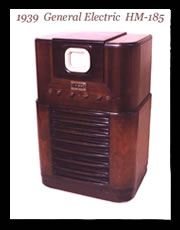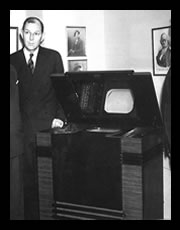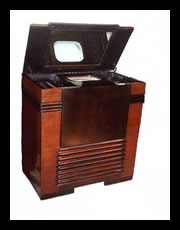
1939 General Electric Model HM-185

1939 FCC members inspecting an RCA-12 set prior to launch approval

RCA TRK-12 top-of-the-line television for 1939
Electronic television
Philo Taylor Farnsworth introduced the first electronic TV system in 1927. He used an image dissector for the camera (transmitter), and he used a CRT for the monitor.
The electron gun that receives the electrical signal produces an electron flow that is dependent on the strength of the electrical signal. The electron beam will travel through the vacuum tube to the screen. The screen is covered by fluorescent layer that brightens when it is impacted by electrons. The greater the number of electrons impacting the screen, the brighter the screen becomes. The path of the electrons, called the raster scan pattern, is controlled by an electrical field between the deflection plate on both the horizontal and vertical axes.
The image is projected on the electric cell, which is excited by light and emits electrons. By using the same principle with the CRT, the deflection plates on the horizontal and vertical planes work together to make only a small area of the Photo Electric Cell through which the electrons can pass to the electron sensor behind the aperture. Both the horizontal and vertical deflection plates work as a raster scan technique. The drawback of this technology is that even sunlight is not sufficent for capturing the image. It requires a powerful and intense light source.
Did you know?
In 1977, More than 75% of TV-equipped homes were able to receive color on one or more sets.
